Hello Friends!
Welcome to Bright Green Futures, Episode Twenty-Seven: Zines, Cultural Change, and Storytelling in the Underground
I created Bright Green Futures to lift up stories about a more sustainable and just world and talk about the struggle to get there.
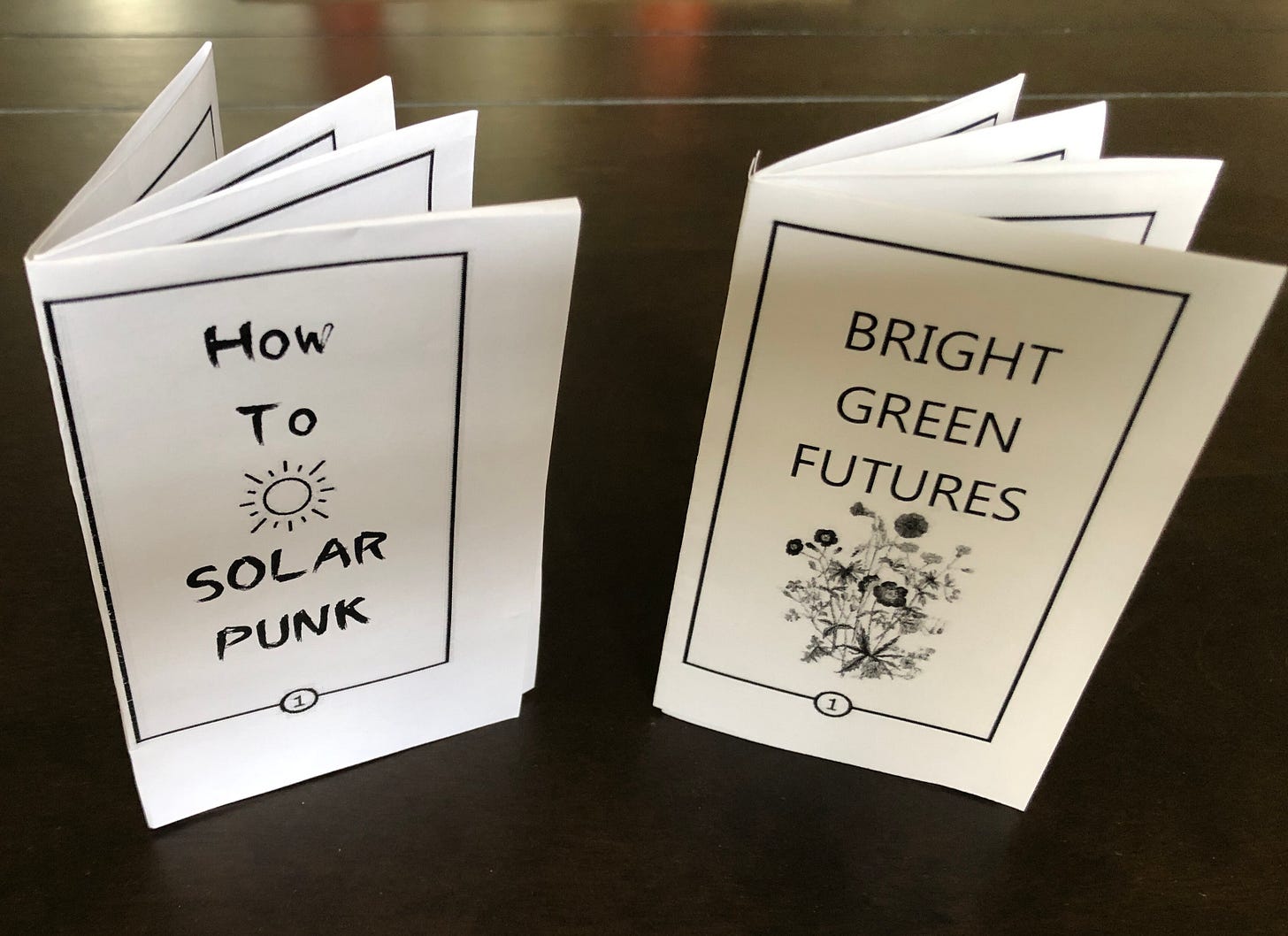
I started making zines about three years ago. I’ve only made a few, but I was entranced by this DIY approach to mini storytelling popping up here and there on the interwebs. It fell into the category of “things that have been around forever but are getting new life online” and I’ve learned those can be signals of what’s brewing in the underground, a place where I believe solarpunk and the kind of storytelling we lift up here on the pod still reside.
The idea that something isn’t important until it “scales up” or “hits the mainstream” is something I’ve been heavily interrogating for a while. I think that’s actually the opposite of how cultural change works. A viral video doesn’t change the culture; a video goes viral because it resonates with or encapsulates cultural change already under way.
And that cultural change happens almost entirely in what I call “the underground”—which is really just my shorthand for things that are happening below the radar, things we may all be aware of or even doing ourselves but don’t see represented in mainstream cultural narratives about “the way things are.”
Cultural Change
As Ted Gioia says in his fantastic essay about the state of culture in 2025: "The culture always changes first. And then everything else adapts to it." He calls it the underground too—or the counterculture or the resistance, but those words have their own rather more specific or even historical meanings.
I like “the underground” because it feels descriptively accurate. The kind of culture change I’m talking about happens at the mycelial network level. It’s the cultural connective tissue that remains hidden under the soil but literally affects every living thing and makes it all work. Even the captivating analogy of the mycelial network itself is an example of how this works: the world was becoming increasingly connected long before science discovered these tiny mushroom filaments that were basically the life-support system of the world. But that scientific discovery quickly entered the culture as an analogy for so much of modern life because it encapsulated a cultural change already underway.
I think there is a lot of cultural change happening right now and solarpunk—the work of telling stories different from the cultural mainstream—is part of that. Solarpunk values and ideas and stories are busy churning in the underground, laying the foundation of change.
With political events being what they are, I thought solarpunk would remain small for a long time, that people weren’t ready for it and wouldn’t be for who knew how long. But I've changed my mind: I see more people than ever seeking it out, questioning the dystopian narratives, clamoring for something different. It's still in the underground—its ideas are highly subversive, so it almost has to remain underground, fermenting change for a long time—but that is where cultural innovation occurs. That’s how it happens.
I see folks despairing that solarpunk hasn’t “scaled up” and I’ve been questioning the premise of that. “Scaling up” is a term and a metric that comes straight out of the tech industry, which is a huge part of the problem right now and hugely anti-solarpunk, especially with AI companies’ assault on arts. The most direct and egregious example of that right now is OpenAI ripping off Studio Ghibli’s art style from Hayao Miyazaki, who is famously anti-AI and whose work embodies many solarpunk values.
There’s a meme going around that says...
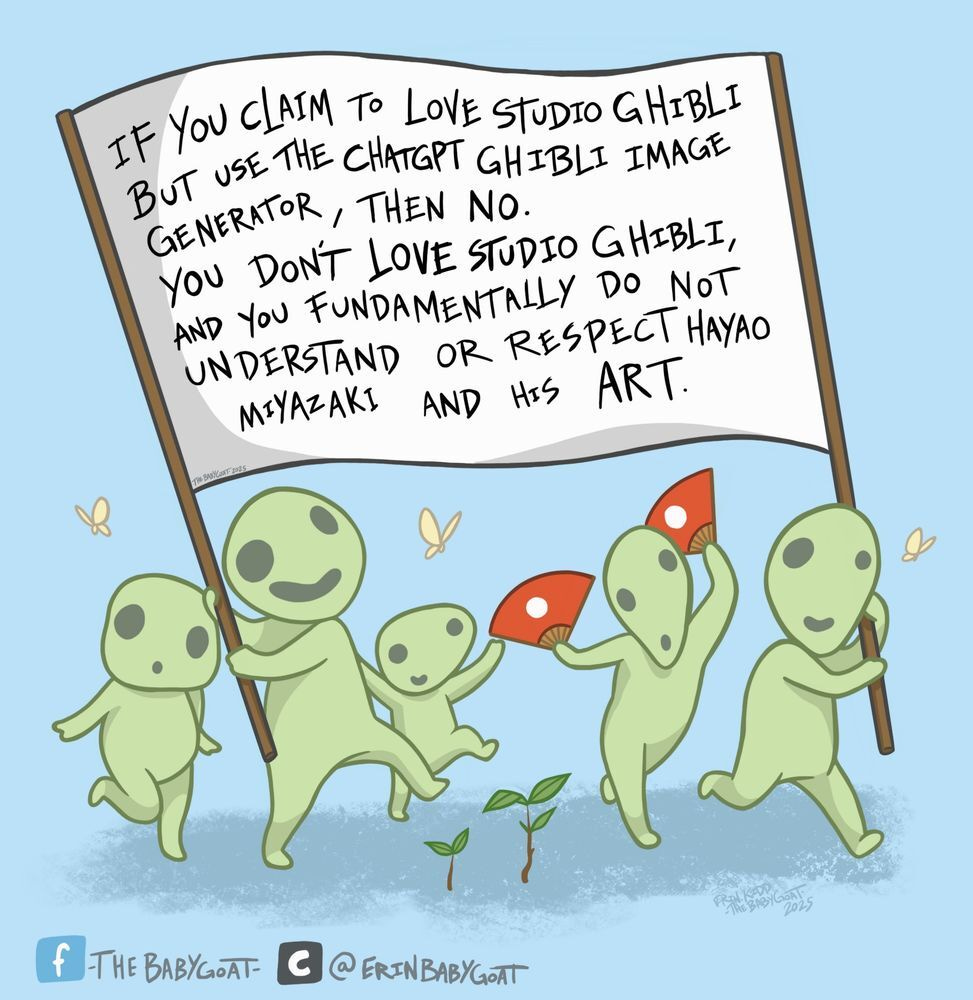
In other words, you gonna steal Studio Ghibli art and try to pretend you’re cool? Good luck with that.
It’s a nearly perfect metaphor for the cultural poverty of the tech industry, where they brag about blatant theft from a beloved creator who has actual alt-storytelling vision. The recent spat of stories about how the fascists love of AI imagery is another signal about where the cultural battle lines lie.
Episode 20 of the pod “Technofeudalists vs. Solarpunk” just gets more relevant with time, so that’s worth checking out if you haven’t listened to it already.
Storytelling in the Underground
Back to cultural change and storytelling in the underground.
One of the great challenges of writing outside normal storytelling paradigms is that it’s hard work. It's challenging for experienced storytellers and relatively new ones alike. Experienced storytellers may have more craft skills but they've also spent more time reinforcing the "norms" of storytelling through their works; new storytellers might have great, innovative new ideas—and importantly might have their finger on the pulse of the cultural zeitgeist—but they’re still learning the craft. And they’re still influenced by all the stories that came before, as all storytelling inescapably is.
As a sidebar: I refuse to use any of the generative AI tools, but very early on, I did prompt chatGPT to spit out three short stories, testing a theory I had. The first two were a horror and a romance, and the results at least resembled those genres. Then I asked it to text-predict its way through a solarpunk story… and it was like the bot had run out of words. It spit out a few trite sentences and gave up. As I suspected, it had nothing to draw upon—the corpus of solarpunk stories is incredibly thin and well-buried underground.
This is one reason why the pod exists: to find the storytellers doing this innovative cultural work and not only lift up the stories so folks can find them, but connect the storytellers to one another, so they can learn from and support each other. It’s an embodiment of solarpunk values to do such a thing, and it’s one reason I’m so excited about the new Bright Green Futures anthology. The stories in the anthology are distinct but the community of authors is very connected. I’ll have more about that at the end of the pod.
But the point is: it’s difficult to create stories that go counter to mainstream storytelling’s invisible rules about what counts as story and what doesn’t, rules which get enforced at every level from the writer’s circle to the Hollywood studio to even the readers’ and viewers’ expectations. This is why creators need to gather together in the underground, seeking out other artists who share their visions and who they can learn from.
Even while we’re in community, respecting individual authorial voice is so important: coherence in creative vision comes from people really digging deep and creating what they want to see, on the page and on the screen. The nature of creativity is there are infinite modes, and group-creative-work definitely works for some—case in point is the TV and film industry. But even there, strong creative vision carries the day, especially when battling against the deadening influence of AI and the forces of status quo that want to suppress subversive storytelling.
The new breakout solarpunk movie Flow is a fantastic example of this.
Flow didn't break out because it was a Pixar film — it was the vision of a tiny team in Latvia. They were a small group with a strong vision that worked for years on something completely different, very outside all the storytelling paradigms, and it "went viral" and won an Oscar because it was innovative and different... which it was allowed to be because it operated outside the normal channels.
Flow didn’t “scale up” — it broke out like a weed through concrete, due to the sheer power of its vibrant vision. Ideas don't spread only when a studio exec puts it on the big screen. Hollywood and mainstream presses almost definitionally lag behind the underground. Ideas germinate everywhere at once and grow where they find fertile ground.
Flow germinated in a small team working their vision and it grew wild because the ground was fertile for its message.
Zines Making a Comeback
Which brings me back to how the underground is constantly mulching, constantly making fertile space for new ideas to germinate. And why zines are making a comeback.
First I should clarify that I use the word “zine” interchangeably for two very different things: one is a contraction of the word “magazine” which could be any kind of collection of words and images but “zine” generally refers to online sci-fi and fantasy short story magazines that are themselves a fertile underground for storytelling. The mainstream has its own form of this: the Atlantic and National Geographic are magazines but they are not zines. Clarkesworld and Solarpunk Magazine are zines.
But the zines that I’m talking about today are the DIY kind that anyone can make, often simple printouts or hand-illustrated, nothing fancy, in fact the not-fancy-ness of them is a key aspect. And so are the methods of distribution. According to Wikipedia a zine is: “short for magazine or fanzine and is a small-circulation self-published work of original or appropriated texts and images, usually reproduced via a copy machine. Zines are the product of either a single person or of a very small group, and are popularly photocopied into physical prints for circulation.”
Zines have a long history in feminist movements, the punk scene, and all kinds of marginalized cultures: in other words, the underground.
When I saw zines having a resurgence, popping up online a few years ago, I was immediately intrigued and wanted to try my own hand at it. I fumbled about—which is exactly how you know you’re doing something cool and creative—and eventually found my footing with my How to Solarpunk zine. I repurposed a Mastodon post that was more like a poem and illustrated it with simple icons to tell a story in a mini 8-page booklet. You can print it with a standard black-and-white printer on an 8.5” x 11” piece of paper, which is a key part of zine-making — having it be accessible and easy to share. There’s a small trick in the folding to make it work, but I also made a how-to video on that which has gotten a lot of shares.
And because we live in the internet age now, I made a tiktok which pages through the 8 pages of the How to Solarpunk zine and set it to music. Plus my cat photobombed it. Perfect internet magic.
This week, I made another zine, this one about why we tell hopeful climate fiction stories, and in celebration of the upcoming release of the Bright Green Futures anthology. I make a tiktok of that one as well, which I like quite a lot. If you’re not having fun with these things, what are you even doing?
And while the videos are great, zines are meant to be shared physically as well as digitally. So I’ll be dropping them in Little Free Libraries all over town and handing them out at several upcoming local conferences where I’ll be tabling with my solarpunk stories.
The links to download the zines, the video on how to fold them, and the tiktoks can all be found in the shownotes. Lots of links in today’s episode so be sure to check out the end of the post for all of that.
In this political moment, when it’s easy to see the powerful corrupting and degrading so much of the world, it’s hard to remember the underground exists. That it is, by its nature, flying below the radar. It’s hard to know that indie booksellers are out there selling subversive books by the wagonload. That people are circulating ideas and hand-crafted zines and material and emotional support everywhere.
It’s easy to forget that we are the culture. That our voluntary acts—where we shop, what we buy, what we read and watch, what we celebrate and share, how we build communities of care—that those things are what define the culture.
Being the change you want to see in the world is exactly how you plant strong seeds, how you create fertile ground, how you grow a better world, one worth fighting for.
This is a time of great change, friends, and a lot of it is bad.
But as my friend, fellow solarpunk, and author in the upcoming anthology Renan Bernardo said way back in Episode Six of the pod: “We have to occupy the evil places and make them good.”
Exactly so.
Where to Find Sue (all events in Pittsburgh area)
April 26th (11a - 2p): Mt Lebanon Galleria Book Show
May 29th (1p - 6p): Solarpunk Future 2025
May 31st (10a - 5p): Pittsburgh Festival of Books
July 25 - 27: Confluence SFF Conference 2025
These hopeful climate-fiction stories include clicky space centipedes, sentient trees, a flooded future Rio de Janeiro and characters trying to find their place in a climate-impacted world. Each story imagines a way for us to survive the future, together.
Story Theme Words
CLIMATE ANXIETY
CLIMATE RESTORATION
CLIMATE ROLES
CLIMATE CONNECTIONS
CLIMATE RESILIENCE
CLIMATE HERITAGE
Check out the Featured Stories and Hopeful Climate Fiction lists for further reading. Also check out the Academic Studies section.
LINKS Ep. 27: Zines, Cultural Change, and Storytelling in the Underground
Download Zines: Bright Green Futures and How to Solarpunk
Stop Sharing the Ghibli AI Slop, What is Wrong With You by Luke Plunkett
Open AI’s Studio Glibli meme facotr is an insult to art itself by Brian Merchant (Blood in the Machine)
AI: The New Aesthetics of Fascism (New Socialist)
History of Zines (Wikipedia)
Anger is Not the Opposite of Hope (Sue’s blog)
Indie Bookseller and the wagonloads of books people are buying (Tiktok)






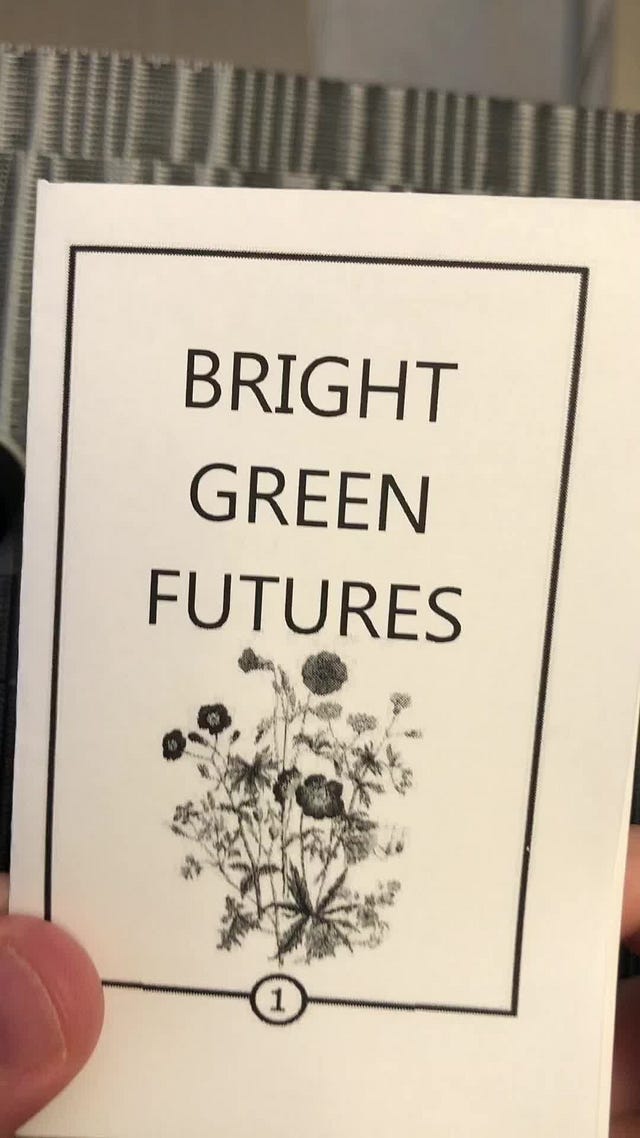


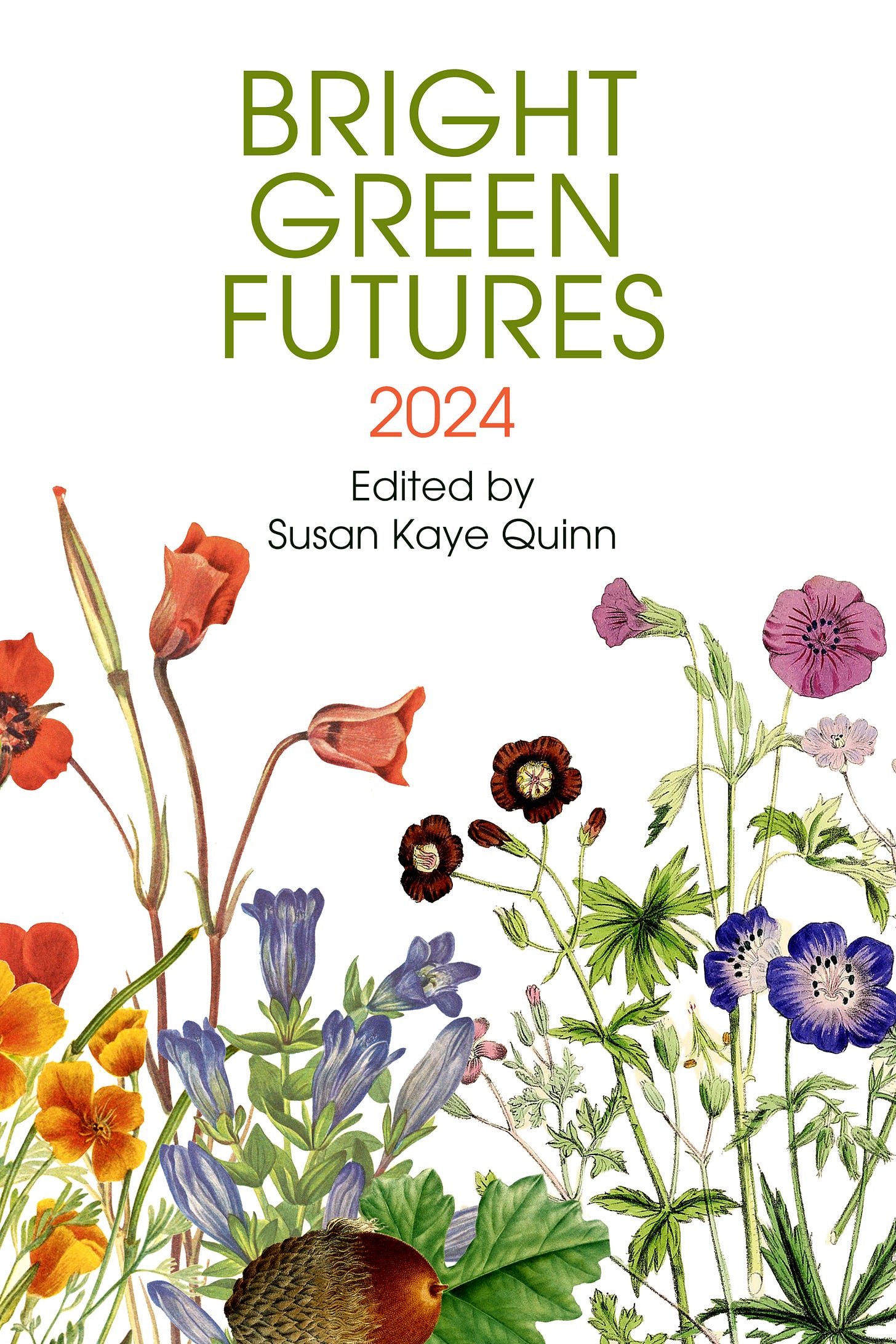





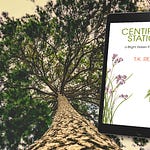



Share this post